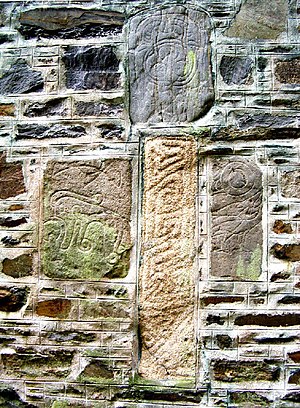Fyvie

Fyvie is a village and parish in the Formartine area of Aberdeenshire, lying alongside the River Ythan and the A947 road. It is thought that the name Fyvie is derived from Fia-chein meaning 'Deer hill'.
Fyvie Castle
Fyvie Castle is reputed to have been built by King William the Lyon in the early thirteenth century. It was the site of an open-air court held by King Robert the Bruce and home to the future King Charles I as a child.
The village's school, with around 125 pupils, serves the surrounding rural area.
Church
St Peter's Church was built in the early nineteenth century on the site of a medieval church. Built into the east gable are three Class I Pictish symbol stones and a Class III Pictish cross.[1]
The church displays some Louis Comfort Tiffany stained glass windows.
Folk tradition
The song The Bonnie Lass o' Fyvie tells of a captain of dragoons who dies for the love of a Fyvie girl. Additionally, the song, Andrew Lammie, tells of the doomed love of a local miller's daughter, Annie, for Lord Fyvie's trumpeter. Both of these songs may have historical basis - the young woman's grave is said to be in Fyvie churchyard.
One of the prophecies of Thomas the Rhymer relates to Fyvie, predicting it will never flourish until a particular three stones are found (a prophecy obviously pre-dating the church with its three Pictish runestones).
References
- ↑ "St Peter's Church, Fyvie". Aberdeenshire Council. http://www.aberdeenshire.gov.uk/smrpub/shire/detail.aspx?refno=NJ73NE0001. Retrieved 5 April 2011.
Outside links
| ("Wikimedia Commons" has material about Fyvie) |
- Location map: 57°25’38"N, 2°23’53"W
- Fyvie School
- Fyvie School Parent Forum
- Fyvie Scouts Web Page
- Fyvie Folk Club
- Mill o' Tifty's Annie

This Aberdeenshire article is a stub: help to improve Wikishire by building it up.
